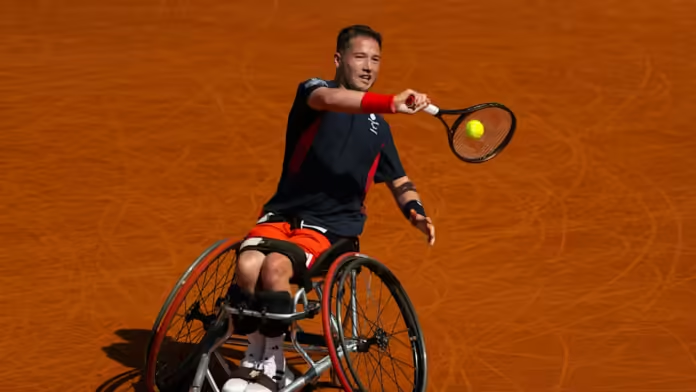Wheelchair Tennis Paralympics 2024 are set to be an extraordinary showcase of resilience, skill, and determination. Among the many sports featured in the games, wheelchair tennis stands out not only for its competitive edge but also for the remarkable stories of the athletes who participate. Wheelchair tennis, a sport that combines the precision of tennis with the adaptability required for wheelchair use, has evolved into one of the most thrilling events at the Paralympic Games. As we approach the Tokyo 2024 Paralympics, the anticipation for this event is palpable, and the stage is set for an unforgettable display of athleticism.
Wheelchair Tennis Paralympics 2024
The 2024 Paralympic Games in Tokyo will be a landmark event for wheelchair tennis, bringing together the world’s best athletes to compete on an international stage. This edition of the games promises to be particularly special, with new challenges and opportunities for competitors. The wheelchair tennis competition is expected to draw significant attention, not just for the intense matches but also for the stories of perseverance and triumph that are synonymous with the Paralympic movement. Fans and spectators around the world are eagerly awaiting the start of the games, which will feature athletes who have overcome tremendous odds to reach this pinnacle of their sport.
History of Wheelchair Tennis in the Paralympics
Wheelchair tennis was first introduced to the Paralympic Games in 1992 in Barcelona, and since then, it has grown in both popularity and prestige. Initially a demonstration sport, it quickly gained full medal status, reflecting its increasing importance within the Paralympic movement. Over the years, the sport has seen numerous advancements, both in terms of athletic performance and technological innovation. The inclusion of wheelchair tennis in the Paralympics has also helped to raise awareness about the abilities of athletes with disabilities, showcasing their skill and dedication on a global platform.
Rules and Regulations of Wheelchair Tennis
Wheelchair tennis follows the same basic rules as able-bodied tennis, with a few key modifications to accommodate the use of a wheelchair. One of the most notable differences is the “two-bounce rule,” which allows the ball to bounce twice before it must be returned, with the first bounce being within the court boundaries. This adjustment ensures that the game remains competitive while accounting for the unique challenges faced by wheelchair athletes. The court dimensions, scoring system, and equipment used are largely the same as in traditional tennis, ensuring that the sport retains its integrity and excitement.
Categories in Wheelchair Tennis
Wheelchair tennis is divided into several categories based on the classification of the athletes. The two main categories are the Open Division, which includes athletes with any kind of permanent physical disability that affects their lower limbs, and the Quad Division, for athletes with impairments in both their lower and upper limbs. This classification system ensures a level playing field, allowing athletes to compete against others with similar levels of ability. The distinctions between these categories also add an extra layer of strategy and skill to the game, as athletes must adapt their play style to their specific physical capabilities.
Top Athletes to Watch in 2024
As the Paralympics 2024 approach, several wheelchair tennis players have emerged as top contenders. Among them, Shingo Kunieda of Japan, a multiple-time Paralympic champion, is expected to be a major draw. Kunieda has dominated the sport for years and will be looking to add another gold medal to his already impressive collection. On the women’s side, Diede de Groot of the Netherlands, known for her powerful serves and strategic play, is another athlete to watch. These players, along with many others, will be aiming to leave their mark on the Tokyo Paralympics, making every match a must-see event.
The Road to Tokyo: Qualifying for the Games
Qualifying for the Paralympics is no easy feat, and wheelchair tennis is no exception. Athletes must compete in various international tournaments to earn enough points to secure their spot in the games. The qualification process is rigorous, designed to ensure that only the best of the best make it to the Paralympic stage. For many athletes, this journey is years in the making, involving countless hours of training, travel, and competition. The road to Tokyo is paved with challenges, but for those who make it, the reward is the opportunity to compete at the highest level of their sport.
Training Regimens of Paralympic Tennis Players
The training regimens of Paralympic wheelchair tennis players are as demanding as they come. These athletes must maintain peak physical condition, often working with specialized coaches and trainers to develop strength, agility, and endurance. Training typically includes a mix of on-court practice, strength training, and conditioning exercises, all tailored to the specific needs of the athlete. Nutrition and mental preparation are also critical components of their regimen, ensuring that they are ready to perform at their best when the games begin. The dedication and discipline required to compete at this level are truly inspiring, reflecting the extraordinary commitment of these athletes.
Technological Innovations in Wheelchair Tennis
Technology plays a crucial role in wheelchair tennis, with advancements in wheelchair design significantly impacting the sport. Modern tennis wheelchairs are lightweight, highly maneuverable, and customized to fit the individual athlete’s needs. Innovations such as adjustable seating, advanced materials, and improved wheel designs have all contributed to enhanced performance on the court. These technological improvements not only allow athletes to move more efficiently but also reduce the risk of injury, enabling them to focus on their game. As technology continues to evolve, we can expect to see even more exciting developments in the future of wheelchair tennis.
Impact of COVID-19 on the Paralympics 2024
The COVID-19 pandemic has had a profound impact on the Paralympics 2024, affecting everything from training schedules to qualification events. The pandemic forced the postponement of many tournaments, and athletes had to adapt to new health and safety protocols. Despite these challenges, the Paralympic community has shown remarkable resilience, with many athletes continuing to train and compete under difficult circumstances. The Tokyo 2024 Paralympics will likely be influenced by ongoing pandemic-related restrictions, but the spirit of the games remains as strong as ever, with athletes and organizers committed to making the event a success.
The Paralympic Spirit: Beyond Competition
While the Paralympics are undoubtedly about athletic competition, they are also about much more. The games represent a celebration of human potential and the power of sport to bring people together. For many athletes, the Paralympics are an opportunity to inspire others and to demonstrate that disability does not define their capabilities. The Paralympic spirit is one of perseverance, resilience, and hope, and it extends beyond the boundaries of the games themselves. Through their participation, these athletes are not only competing for medals but also challenging societal perceptions of disability and promoting greater inclusion and understanding.
Notable Matches in Paralympic Wheelchair Tennis History
Over the years, Paralympic wheelchair tennis has produced many memorable matches that have captivated audiences worldwide. From epic finals to unexpected upsets, these matches have showcased the skill, determination, and sportsmanship of the athletes involved. One such match was the 2008 Paralympic men’s singles final, where Shingo Kunieda secured his first gold medal in a thrilling contest. Another unforgettable moment came in 2016 when Jiske Griffioen of the Netherlands claimed the women’s singles title in Rio. These matches, and many others like them, have helped to cement wheelchair tennis as one of the most exciting sports in the Paralympic program.
The Role of Coaches in Wheelchair Tennis
Coaches play an integral role in the success of wheelchair tennis athletes. They are responsible for developing training programs, analyzing opponents, and providing the necessary support to help their athletes perform at their best. Coaching in wheelchair tennis requires a deep understanding of the sport as well as the specific needs of athletes with disabilities. Coaches must be adept at adapting their strategies to the unique strengths and challenges of each player, ensuring that they are prepared both physically and mentally for competition. The relationship between coach and athlete is often one of mutual respect and trust, built over years of hard work and collaboration.
Inclusion and Representation in the Paralympics
The Paralympic Games are a powerful platform for promoting inclusion and representation in sports. Wheelchair tennis, like many other Paralympic sports, provides athletes with disabilities the opportunity to compete at the highest level and to be recognized for their abilities rather than their disabilities. The visibility of Paralympic sports has increased significantly over the years, helping to challenge stereotypes and promote greater acceptance and understanding of people with disabilities. The Paralympics 2024 will continue this tradition, showcasing the incredible talent and diversity of the athletes involved and inspiring future generations to pursue their own athletic dreams.
The Evolution of Wheelchair Design in Tennis
The design of wheelchairs used in tennis has evolved dramatically over the years, driven by advances in technology and a better understanding of the needs of athletes. Early models were heavy and difficult to maneuver, limiting the performance of players. Today’s wheelchairs are lightweight, durable, and highly customizable, allowing athletes to move quickly and efficiently on the court. Features such as cambered wheels, adjustable seating, and specialized grips have all contributed to improved performance. These innovations have not only made the sport more competitive but have also opened up new possibilities for athletes, allowing them to push the boundaries of what is possible in wheelchair tennis.
Paralympics 2024: Schedule and Key Dates
The schedule for the Paralympics 2024 is packed with exciting events, and wheelchair tennis will be one of the highlights. The competition will take place over several days, with matches scheduled at various times to accommodate different time zones and audiences. Key dates to watch include the opening ceremony, the preliminary rounds, and, of course, the finals, where the medals will be decided. Fans can look forward to a thrilling tournament, with matches that promise to be both intense and highly competitive. Whether you’re attending in person or watching from home, the Paralympics 2024 is sure to be an unforgettable experience.
How to Watch Wheelchair Tennis at the Paralympics 2024
Watching wheelchair tennis at the Paralympics 2024 will be easier than ever, thanks to extensive media coverage and online streaming options. Major broadcasters around the world will be providing live coverage of the games, including the wheelchair tennis events. For those who prefer to watch online, streaming services will offer live feeds and replays, allowing fans to catch all the action from the comfort of their homes. Social media platforms will also be buzzing with updates, highlights, and commentary, making it easy to stay informed and engaged throughout the tournament. Whether you’re a die-hard tennis fan or new to the sport, there will be plenty of ways to enjoy the Paralympic wheelchair tennis competition.
The Future of Wheelchair Tennis Beyond 2024
Looking beyond the Tokyo 2024 Paralympics, the future of wheelchair tennis appears bright. The sport continues to grow in popularity, attracting new fans and inspiring a new generation of athletes. Technological advancements are likely to further enhance the performance of players, while greater visibility and media coverage will help to elevate the sport’s profile. In addition, ongoing efforts to promote inclusion and accessibility in sports will ensure that wheelchair tennis remains a key part of the Paralympic program. The future holds exciting possibilities for wheelchair tennis, with the potential for even more thrilling competitions and inspiring stories in the years to come.
Sponsorship and Support for Paralympic Athletes
Sponsorship and financial support are critical for the success of Paralympic athletes, including those competing in wheelchair tennis. Many athletes rely on sponsorship deals to cover the costs of training, equipment, travel, and other expenses associated with competing at an elite level. In recent years, there has been a growing recognition of the value of sponsoring Paralympic athletes, with companies and organizations increasingly stepping up to provide the necessary support. This trend is expected to continue into 2024 and beyond, with more opportunities for athletes to secure the backing they need to achieve their goals. Sponsorship not only helps individual athletes but also contributes to the overall growth and development of Paralympic sports.
Inspirational Stories from Paralympic Wheelchair Tennis
The Paralympic Games are full of inspirational stories, and wheelchair tennis is no exception. Many athletes have overcome incredible challenges to reach the Paralympic stage, demonstrating extraordinary resilience and determination. These stories often resonate with fans and inspire others to pursue their own dreams, regardless of the obstacles they may face. One such story is that of Esther Vergeer, a former Dutch wheelchair tennis player who won multiple Paralympic gold medals and remained undefeated for over a decade. Her legacy continues to inspire both current and future athletes. These stories remind us that the Paralympics are about more than just winning; they are about the triumph of the human spirit.
Community and Global Impact of Wheelchair Tennis
Wheelchair tennis has a significant impact beyond the courts, contributing to broader social change and community development. The sport promotes physical activity and healthy lifestyles among people with disabilities, encouraging greater participation in sports and recreation. It also plays a role in raising awareness about disability issues, helping to break down barriers and promote inclusion. The global reach of the Paralympics ensures that the message of wheelchair tennis is heard around the world, inspiring people of all abilities to engage in sports and lead active lives. The community and global impact of wheelchair tennis will continue to grow, driven by the passion and dedication of its athletes and supporters.
The Paralympic Movement: A Force for Good
The Paralympic Movement is more than just a series of sporting events; it is a powerful force for good in the world. By showcasing the abilities and achievements of athletes with disabilities, the Paralympics challenge stereotypes and promote greater understanding and acceptance of diversity. The games inspire people to look beyond disabilities and see the potential in everyone, regardless of their physical or mental limitations. The Paralympic Movement also advocates for greater accessibility and inclusion in all areas of society, using sport as a platform to drive positive change. As we look ahead to the Paralympics 2024, the impact of this movement will be felt far beyond the stadiums and courts of Tokyo.
FAQs About Wheelchair Tennis Paralympics 2024
What is wheelchair tennis?
Wheelchair tennis is a sport that follows the same basic rules as traditional tennis but with modifications for athletes who use wheelchairs. It is a popular event in the Paralympic Games.
Who are the top players in wheelchair tennis for the 2024 Paralympics?
Some of the top players to watch include Shingo Kunieda from Japan and Diede de Groot from the Netherlands. Both are highly accomplished athletes with multiple Paralympic titles.
How does the classification system work in wheelchair tennis?
Wheelchair tennis has two main classifications: the Open Division and the Quad Division. These classifications are based on the type and extent of the athlete’s physical disability.
When and where will the wheelchair tennis events take place in the 2024 Paralympics?
The wheelchair tennis events will take place during the Tokyo 2024 Paralympics. Specific dates and venues will be announced closer to the event.
How can I watch the wheelchair tennis events at the Paralympics 2024?
You can watch the events through major broadcasters, online streaming services, and social media platforms. Coverage will be available worldwide.
What impact has wheelchair tennis had on the Paralympic Movement?
Wheelchair tennis has significantly contributed to the Paralympic Movement by promoting inclusion, challenging stereotypes, and inspiring people with and without disabilities to participate in sports.
The Paralympics 2024 will be a remarkable event, with wheelchair tennis playing a central role in the games’ success. As athletes from around the world prepare to compete, their stories of perseverance, skill, and dedication remind us of the power of sport to unite and inspire. Wheelchair tennis is more than just a game; it is a testament to the human spirit and a beacon of hope for all who strive to overcome challenges and achieve their dreams. As we look forward to the Tokyo 2024 Paralympics, the legacy of wheelchair tennis will continue to grow, leaving a lasting impact on the world of sports and beyond.
To read the latest articles please visit the home page of Turk Blogs.





